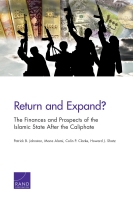PDF file 1.2 MB
 With the end of its territorial caliphate, the Islamic State will almost certainly attempt a comeback. Such efforts will require money. The authors examine the group's history as an insurgency and a self-styled caliphate, drawing from the literature, the group's documents, and interviews with individuals who lived under the caliphate, with a focus on how the group has financed itself. The Islamic State has prided itself on drawing from local funding sources rather than external donations. As a territorial caliphate, it could openly levy taxes and fees and sell oil from fields it controlled to cover its expenses. Now that it can no longer rely on such sources, the group will go with activities that it has used successfully in the past, as an insurgency. Criminal activities will prove useful, with its members seeking to extort, kidnap, steal, smuggle, and traffic to obtain the money they need to finance the group's activities. On top of this, the Islamic State likely has detailed information on the population it once ruled, and it appears to have sizable assets in reserve. As an insurgency, rather than a territorial government, its expenses are far lower than they were at the peak of its power. Accordingly, the United States will need to stay involved with counter–Islamic State activities across several lines of effort, including counterfinance and potentially including military action.
With the end of its territorial caliphate, the Islamic State will almost certainly attempt a comeback. Such efforts will require money. The authors examine the group's history as an insurgency and a self-styled caliphate, drawing from the literature, the group's documents, and interviews with individuals who lived under the caliphate, with a focus on how the group has financed itself. The Islamic State has prided itself on drawing from local funding sources rather than external donations. As a territorial caliphate, it could openly levy taxes and fees and sell oil from fields it controlled to cover its expenses. Now that it can no longer rely on such sources, the group will go with activities that it has used successfully in the past, as an insurgency. Criminal activities will prove useful, with its members seeking to extort, kidnap, steal, smuggle, and traffic to obtain the money they need to finance the group's activities. On top of this, the Islamic State likely has detailed information on the population it once ruled, and it appears to have sizable assets in reserve. As an insurgency, rather than a territorial government, its expenses are far lower than they were at the peak of its power. Accordingly, the United States will need to stay involved with counter–Islamic State activities across several lines of effort, including counterfinance and potentially including military action.
No comments:
Post a Comment